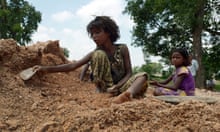Charles Dickens was outraged by child labour and for good reason: he had first hand experience of working long hours for little pay in bad conditions.
By the time Dickens came to chronicle his childhood experiences during the 1820s in David Copperfield, the first steps had been taken to end the exploitation of children by unscrupulous employers. There was a parliamentary inquiry in 1832 followed by legislation the following year so that a child working in a textile mill could work no more than an eight-hour day.
That was almost two centuries ago, yet in parts of the world child labour is still rife. There has been much discussion during 2016 about the effects of globalisation, almost all of it focused on problems it has caused for those struggling in developed countries.
But globalisation is a two-way street. At one end there’s the factory worker thrown on the scrapheap because it is cheaper to outsource production to a low-wage country. At the other there are workers making the trainers and the T-shirts. And many of them are children who should be playing with toys rather than making them. In the west, a company would never survive the public opprobrium following revelations that children as young as 10 were working 45-hour weeks.
Multinational corporations know that consumers are not especially keen on child exploitation in developing countries either, so many of them have signed codes of practice designed to ensure that children are not going through the sort of experiences suffered by Dickens in the 1820s.
That, though, is the reality according to a new report that looks at the link between child labour and education in the slums of one city – Dhaka, the capital of Bangladesh. The findings are worrying.
Bangladesh has a good record on human development. Poverty levels have fallen and it is close to getting every child in primary school. It has taken steps to achieve gender equity. Put simply, plenty of countries could learn some lessons from Bangladesh.
But the report written by Maria Quattri and Kevin Watkins for the UK thinktank, the Overseas Development Institute, found that child labour was rife in the slums, in part because families were desperate for the extra income their children were bringing in and in part because the poor quality of education meant dropout rates were high.
Dhaka is one of the world’s fastest growing mega cities. Migration from rural areas to the cities has been a big part of Bangladesh’s economic development, but urbanisation has been accompanied by rapid growth in slums.
The ODI study looked at slums in eight of Dhaka’s administrative units drawing on a large sample of 2,700 households in which children as well as adults took part.
It found a high incidence of children working from the ages of six to 14, with an average rate of 15% from across the eight survey sites. Another 15% were neither in school nor working. The overwhelming majority of working children were out of the school.
There are globally agreed rules drawn up by a UN body, the International Labour Organisation, governing the employment of children, and these make a distinction between child work and child labour.
Convention 138 allows children from the age of 13 (12 in the poorest countries) to do light work provided it doesn’t affect their attendance at school. Light work means work that is not hazardous – such as working down a mine, on a construction site or operating a machine in a factory – up to a maximum of 14 hours a week.
Writing in the Observer, a group of academics voiced opposition to calls from the UN for tougher action to stop children working, saying that the focus should instead be to avoid dangerous occupations and exploitation.
But the ODI study revealed that almost all the working children in the Dhaka slums were involved in what the ILO would classify as child labour, with hazardous work featuring prominently. Almost all were working more than 42 hours a week, with child labour levels rising steadily from 8% at the age of 10 to 45% by 14. Two-thirds of girl child labourers were employed making clothes, a big export earner for Bangladesh, which has an estimated 7,000 garment factories, employing about 5 million workers.
Some of these are direct suppliers for foreign brands. They tend to be the bigger operations, but they sub-contract work to a large – less well policed – informal sector.
“We do not state outright that named foreign brands can be linked to factories employing child labour,” the ODI report says. “However, it stretches credibility to assume that the supply chains for these brands do not include significant employment of child labourers.
“First, with over 60% of working girls and 13% of working boys reporting employment in the garment sector, this is the single largest source of employment in our sample. Second, the operations of direct and indirect exporters, and formal and informal suppliers, are deeply integrated. Widespread sub-contracting renders it highly probable that children are producing clothing destined for international supply chains.”
Children are driven into work by necessity. Poor families send their sons and daughters out to work to make ends meet: the survey found that the wages earned by children equalise the average incomes of households with and without working children.
The ODI report found that children are entering the labour market having had on average four years of schooling, typically of a poor quality. Basic literacy and numeracy skills are low, meaning that the children who drop out of school are on course for a life in lowly-paid jobs.
There are obvious ways of tackling child labour in Dhaka’s slums. The government could provide more effective enforcement to ensure compulsory primary education. It could raise its spending on education from 3% of national output, a level well below that in sub-Saharan Africa. It could raise the school leaving age. It could introduce a system of cash transfers that would compensate households for the foregone wages of their children, which average $47 a month for those aged six to 14.
One thing is certain: Bangladesh will pay a price if it fails to crack down on child labour. It is recognised that having a well-educated workforce is vital for economic development, which is why the UN has made universal secondary education one of its sustainable development goals to be achieved by 2030. This won’t happen in Bangladesh (and plenty of other countries) without a stronger commitment to eradicating child labour, which in turn means free, compulsory education for those aged six to 14.
It might also be time for western companies, governments and consumers to ask themselves a simple question: if child labour was wrong in the London of the 1820s, what makes it right in the Dhaka of the 2010s?











